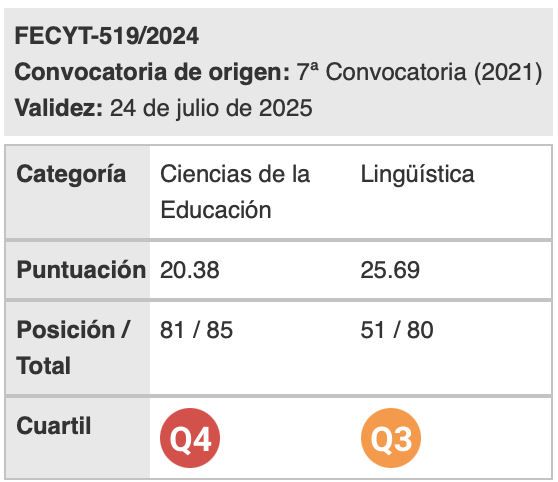Los medios de comunicación y la enseñanza de valores interculturales: Una aproximación didáctica a los valores reflejados en los <i>sitcoms</i>
Palabras clave:
Culture, Television, Cultural studies, Language learning, GlobalizationResumen
With the turn of the century we have seen a string of political and cultural changes that have had a deep impact on economy and technology. The “global culture” phenomenon is nowadays a common concept spread through the mass media, namely television, films and the internet. However, cultural differences persist despite globalization.
As English language teachers, we are aware that language and culture are two indivisible entities, that is to say, the cultural aspects are part of foreign language learning. The main problem the learner faces is the present day development of global culture, since this seemingly international behavior makes it difficult to identify the values that lay within a society’s internal culture. Given the complexity of this concept, we firmly believe that we must help our students identify more subjective cultural nuances that remain unnoticed or in the background, so we can break away from stereotypes.
Television is a window into the values of a society. It is also an effective and powerful tool for language learning, both from the linguistic and cultural angle. Bearing all this in mind, we propose a pedagogical approach to carry out a cultural awareness exercise that enable the students understand the values of the American society as portrayed in the situation comedy Friends.
Descargas
Citas
Babcock, R. y B. Du-Babcock (2001). Language-based communication zones in international business communication. The Journal of Business Communication 38(4), 372-412.
Berman, R. (1987). Sitcoms. Journal of Aesthetic Education, 21(1), 5-19.
Byram, M. (1996). Teaching and assessing intercultural communicative competence.
Clevedon: Multilingual Matters.
Chacón, C.T. y Reyes, F. (2005). El diario de televisión como experiencia didáctica promotora del aprendizaje autónomo del inglés. Acción Pedagógica, 14, 104-110.
Chitnis, K.S., Thombre, A., Rogers, E.M., Singhal. A. y Sengupta, A.
(2006). Dissimilar readings: Indian and American audiences’ interpretation of Friends. International Communication Gazette, 68(2), 131-145.
Cornbleth, C. (2002). Images of America: What youth “do” know about the United States. American Educational Research Journal, 39(2), 519-552.
Ennis, M. (1997). Television, dialogue journals, and feedback in the EFL classroom. The Journal of TESOL France, 4, 30-43.
Feuer, J. (1992). Genre study. In R. Allen (Ed.), Channels of discourse, reassembled (pp. 138-160). New York, NY: Routledge.
Grandío, M. (2007), Recepción de la ficción televisiva norteamericana en España. El caso de Friends. Revista da Associação Nacional dos Programas de Pós-Graduação em Comunicação, 10. (http://www.compos.org.br/seer/index.php/ e-compos/article/view/186) (12/07/2011)
Hall, E.T. (1959). The silent language. New York, NY: Anchor Books/Doubleday.
Hall, E.T. (1976). Beyond culture. New York, NY: Anchor Press/Doubleday.
Hall, S. (1980). Culture, media, language: Working papers in cultural studies. London: University of Birmingham.
Halliday, M. A. K. (1999). The notion of “context” in language education. In M. Ghadessy (Ed.), Text and context in functional linguistics (pp. 1-24). Amsterdam: John Benjamins.
Harrington, L. y Bielby, D. (2005). Global television distribution: Implications of TV ‘traveling’ for viewers, fans, and texts. American Behavioral Scientist, 48(7), 902-920.
Hilmes, M. (2005). The bad object: Television in the American academy. Cinema Journal, 1, 111-117.
Hurd, R. (2007). Taking Seinfeld seriously: Modernism in popular culture. New Literary History, 37, 761-776.
Ibarra Ruelas, A. A. (2005). American values in Canadian TV: Will & Grace. Revista Mexicana de Estudios Canadienses, 9, 87-94.
King, D.L. (2000). Using videos to teach mass media and society from a critical perspective. Teaching Sociology, 28(3), 232-240.
Lieber, R. J. y Weisberg, R. E. (2002). Globalization, culture, and identities in crisis. Journal of Politics, Culture and Society, 16(2), 273-296.
Marc, D. (2005). Origins of the genre: In search of the radio sitcom. In M. M. Dalton & L. R. Linder (Eds.), The Sitcom Reader (pp. 15-24). Albany, NY: State University of New York Press.
Mingiuc, A. (2010). Key concepts of puritanism and the shaping of the American cultural identity. Philologica Jassyensia, 2(12), 211-217.
Olson, S. (1999). Hollywood planet: Global media and the competitive advantage of narrative transparency. Mahwah: Lawrence Erlbaum.
Parks, C. (1994) Closed captioned TV: A resource for ESL literacy education. ERIC Digest, 1-7.
Rajadell Puiggròs, N., Pujol, M. A. y Violant Holz, V. (2005). Los dibujos animados como recurso de transmisión de los valores educativos y culturales. Comunicar, 25. (http://redalyc.uaemex.mx/pdf/158/15825191.pdf) (11/07/2011)
Ruano López, S. (2007).Cultura y televisión: Una controvertida relación. Comunicar, 28, 177-182.
Sapir, E. (1958). Culture, language and personality. Berkeley, CA: University of California Press.
Seeley, H. N. (1974). Teaching culture: Strategies for intercultural communication. Lincolnwood, IL: National Textbook Company.
Taflinger, R. F. (1996). Sitcom: What it is, how it works. (http://public.wsu.edu /~taflinge/sitcom.html) (13/06/2011)
Uhlmann, E. L. (2010). Implicit puritanism in American moral cognition. Journal of Experimental Social Psychology, 47, 312-320.
Varner, I. y Beamer, L. (2005). Intercultural communication in the global workplace (3rd ed.). Boston. MA: McGraw Hill/Irwin.
Vasallo de Lopes, M. I. (2008). Televisiones y narraciones: Las identidades culturales en tiempos de globalización. Comunicar, 30, 35-41.
Weaver, G. (1986). Understanding and coping with cross-cultural adjustment stress. In R. M. Paige (Ed.), Cross-Cultural Orientation: New Conceptualizations and Applications (pp. 111-145). Lanham, MD: University Press of America.
Descargas
Publicado
Cómo citar
Número
Sección
Licencia
Aquellos autores/as que tengan publicaciones con esta revista, aceptan los términos siguientes:
- Los autores/as conservarán sus derechos de autor y garantizarán a la revista el derecho de primera publicación de su obra, el cuál estará simultáneamente sujeto a la Licencia de reconocimiento de Creative Commons que permite a terceros compartir la obra siempre que se indique su autor y su primera publicación esta revista.
- Los autores/as podrán adoptar otros acuerdos de licencia no exclusiva de distribución de la versión de la obra publicada (p. ej.: depositarla en un archivo telemático institucional o publicarla en un volumen monográfico) siempre que se indique la publicación inicial en esta revista.
- Se permite y recomienda a los autores/as difundir su obra a través de Internet (p. ej.: en archivos telemáticos institucionales o en su página web) antes y durante el proceso de envío, lo cual puede producir intercambios interesantes y aumentar las citas de la obra publicada. (Véase El efecto del acceso abierto).

Revista de Lenguas para fines específicos is licensed under a Creative Commons Reconocimiento-NoComercial-SinObraDerivada 4.0 Internacional License.






















